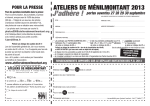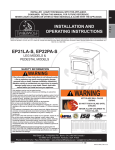Download promoting public apprecia tion for the historic monument in
Transcript
PROMOTING PUBLIC APPRECIA TION FOR THE HISTORIC
IN ITS LARGER ARCHITECTURAL
SETTING :
AN EXPERIMENT
WITH TURKISH SCHOOLCHILDREN
The approach I shall review to promoting public appreciation of historic monuments and their setting in
Turkey may seem a simplistic one. But the problem is
far from simple. It is one that concerns us all, but the
Turkish case is especially relevant. On the one hand,
it contains aIl the conflicting elements present in Europe, while on the other hand it has many exacerbating factors peculiar to less affiuent countries. Thus, it
may throw common difficulties into relief while also
focussing attention on the special challenge in countries where still undocumented treasures of past civilizations are hanging in the balance.
First, Turkey's fund of architectural and archaeological treasures is outstandingly rich, but the nation is
undergoing socio-economic and technological changes
which have no parallel in either its own history or the
experience of modern Europe. In one generation the
pace of the se changes and the sudden shift in values
directly challenges a cultural heritage of centuries.
Ironically, the danger to historic monuments in
Turkey, particularly in urban areas, dates only from
modern times. Fascination with the West, and above
all its technology, undoubtedly began over a century
ago, but its influence was limited. With the founding of
the Republic, rejection of the Ottoman heritage became a virtual creed. Monuments such as baths or covered markets, which had performed the same functions for centuries, were neglected or replaced with
modern structures; entire historic centres were destroyed to make room for new roads.
The early search for a national architecture synthesizing Turkish and international styles has given way to
an almost indiscriminate adoption of international
styles. But the building stands isolated, out of context
with its social and architectural surroundings. The
student of architecture has few indigenous modern
examples to follow. His guides become illustrations in
foreign architectural publications where most often
there is visible only thé single structure detached from
its environment. Increasingly we find buildings which
are indistinguishable from those going up in Beirut;
Europe or America. In this hodge-podge of styles
there is little or no attention to local climatic conditions, architectural surroundings, and the functions the
structure is to accommodate.
MONUMENT
Social changes are also important in bringing about the
demise of whole quarters and many monuments. Until
the twentieth century , Turkish cities functioned much
as they had since Byzantine times. With the structural
changes inherent in modernization,
the physical pattern of cities altered. TraditionaIly,
cities bad been
composed of units or districts that were administratively self-goveming and characterized by the primary
social relationships associated with smaIl settlements.
As identification
with the district disappeared and
anonymity increased this system languished; consequently, so did the monuments. Rather than reorienting the existing system or proposing an innovative solution, modern city-planners simply stamped Western
patterns on the Anatolian landscape. Like the architects, the planners adopted these patterns with little or
no direct experience of living in such an environment.
The preservation of old quarters or an individual
monument within contemporary surroundings can be
achieved. The two are not mutuaIly exclusive. A creative compromise between restorer and planner is feasible where the juxtaposition
of new and old can be
tasteful, vibrant and functional.
But first there must be a general awareness, sensitivity, and respect for both contemporary and ancient surroundings as an integral whole. The people who live in
these areas must be able to demand this quality of
their architects and city-planners. Moreover, students
must grow up with su ch exposure if they are to becorne competent architects.
If we cannot establish such communication I see little
hope for govemment efforts at preserving historic
quarters to have wide or long-Iasting impact. Only if
the people who live and work in these quarters take
pride in thern can they be properly maintained. Only if
they thernselves try to stave off dernolition can we
preserve a few more of these areas.
AlI of us in the profession find that we can communicate su ch ideas to each other with some degree of satisfaction; we aIready are conversant with these basic
notions and have a common vocabulary of sorts. It is
unlikely, however, that an iIliterate peasant or a primary school child who bas recently moved frorn a village to squatter housing in a metropolitan area could
make head or tail out of wbat we say at our meetings.
a
b
Fig. I. -A
c
children's
story book; The Little
Caraviinserai.
by Dalga Necati.
a) First page, showing the caravan stopping at the Caravanserai.
b) Another page, restorers photographing
and examining the building.
c) Illustration
of childrenplaying
in front
of the caravanserai
after restoration.
If asked, we would find it difficult to express in simple
words and concepts within his frame of reference the
ideas we discuss.
Over most of the world, modernization for the general
public has meant first and foremost acquiring the physical comforts and habits of the West while rejecting
traditional life styles. Most magazines, newspapers,
films and schoolbooks in Turkey show people living in
apartment houses, watching television, and driving
cars on wide highways. These are the models to be
imitated. Only a small proportion of the population in
fact lives this way. Yet living in an old house overlooking a small winding street near a square with a
mosque implies backwardness for most. AIl media encourage children to strive for the former pattern, and
to reject or feel dissatisfied with the latter .
To think otherwise may seem to fly against the course
of reason and history. I had, however, a number of
experiences to make me think that public attitudes
could be moulded and latent ones brought into action.
Children seemed to be an important key.
The village museums to be found in many one-room
village schools drove home to me the impact a grade
school teacher can have on a whole community. These
small museums have evolved as teachers encouraged
their pupils to be proud of their village, protect their
ancient monuments, and bring to the museum anything
ancient they might find. ln the se schoolyards one may
find statuary and architectural ornament worthy of any
museum and in the schoolhouse one may corne across
crucial clues for the archaeologist to sites in the area.
This is a remarkable achievement when one remembers that the international black market in antiquities
has reached into every corner of Turkey. These same
villagers are weIl aware that one modest pie ce could
bring more than their annual income if turned over to a
dealer.
I therefore set graduate architects the task of translating the concepts they had been studying in my postgraduate course in the Theory of Restoration into
forms understandable to children of different ages in
Turkey. One goal was instruction, the other was to
corne up with some projects that could be implemented. The students were free to select any medium they
thought effective. They were instructed that this was
not simply an academic exercise to be done in vacuo .
It was to be practical, given the cost and administrative constraints in Turkey. The students were to test
their ideas on classes of children from varied socioeconomic backgrounds. ln developing their approaches they also worked with a professor of child psychology at the university, learning about the colour preferences, spatial understanding, and manual dexterity of
children at different ages.
ln retrospect the experiment has prOduced innovative
work, some of whichwiII
actually be used in schools.
A children's story, The Little Caravanserai,
written
and iIlùstrated by one of the se students, is going to be
printed under the auspices of the Bank of Pious
,
E:SK-\
.,
'E~~R.~E12..1
1>iK-~AT
3A~~A
CAz.IP
y.!!,k)~
HALE""
.SO~MAL
c:j:PK.~L"-1J'.S\I,J
a
O:ZEL
Bi~
lk:kAT Gc!.ST~RMELi"iz.
b
Fig. 2. -Use
of cartoons
as the medium
of expression,
by Puna
Orbay.
a) "Ancien! Monuments should be made attractive so !ha! attention
win no! be directed elsewhere".
b) "We should show special care for aIl old things."
b
a
Fig.
urban
3.
-A
three-dimensianal
enviranment,
by
Puna
stary;
An
appraach
ta
the
camplex
Orbay.
Endowments. It will be ~istributed to 750,000 primary
school children.
Caravanserais, familiar to many children in Turkey,
were once a major unit of the Seljuk and Ottoman
overland transport system (fig. la). As structures they
are virtually complete and thus easy for a child to visualize in a restored condition. ln most instances they
have been abandoned, serving now as a local stable or
storehouse.
The author clearly suggests how a
changed transport network and technology may have
thrust them into obscurity (fig. Ib ). Her approach encompasses both restoration and refunctioning,
where
the ancient monument and modern system serve to
complement each other (fig. tc).
Another approach geared to slightly older children
uses cartoons as the medium for expression. Each one
draws on a situation familiar to aIl yo~ng Turks, but
forces them to look at it from a new angle or to see the
lesson through antithesis, Two caught the eye of many
readers. The first (fig. 20 ) bears the caption, " Ancient
monuments should be made attractive so that attention
will not be directed elsewhere" .The other, while deal-
a) First
page shows
an ancient
fortress
structures.
b) At the last page the ancient fortress
behind
the large modern
emerges from obscurity.
ing with museum displays, has broader import for aIl
things of historic value (fig. 2b). "We should show
special care for aIl old things."
One story also focusses on a typical Turkish house of
the 19th century, presumably abandoned by its owners
in favour of a modem apartment. The illustrations
show how even so-called modem people can find an
old house beautiful. Since the majority of Turkey's
population lives in similar houses, this story is especially successful at showing there can be a common
meeting point and mutual respect.
The more complex urban environment was creatively
handled in a three-dimensional
story (fig. 3a). The
layout is constructed in such a way as to allow the
child to st:e through from the first to the last page. The
structures on each individual page form part of the total urban environment. Gradually an ancient fortress
emerges from obscurity behind the larger modem
structures as the child turns each page (fig. 3b ).
Children often acquire a greater feeling for space, can
e~press their reactions to their environment and order
monuments in their surroundings, when they are given
Fig. 4. -Puzzles
give the freedom
of working
with
hands. An ancient
the freedofi of working with their hands. With this in
mind some students developed puzzles (fig. 4). A
construction set, however, proved the overwhelming
favorite among children. This set combines ancient
building forfis with a visual and instructional manual.
The use of the manual is optional, but in itself is of
particular interest. Since the concept could easily be
modified for use in other national school systems, it is
worth describing in some detail.
The page below selected frofi the manual (fig. Sa),
like aIl the other pages, juxtaposes a photograph of the
particular type of monument with a drawing of the
forfi as contained in the building set. Pieces, construction problems, and vocabulary are accessible to even a
temple by Hüsnü
oguszsoy.
three-year old. Adults, however, proved just as eager
to work with the set as children. The set contains
many addition al pieces so that the users may innovate
beyond the manual (fig. 5b ). Since each of the structures illustrated requires only a small part of the set,
the child is encouraged to express the monument in a
larger set ting. The fortress (fig. 5c) usually sets the initial parameters for a more intricate layout. We were
surprised to find very small children ordering such
complexes. The understanding of the contemporary
survival of structures from very different cultures and
periods is built from each Turkish child's dai Iy expenence.
To watch children exploring and enjoying their his-
a
11<Ale
TARiH
8OYUNCA
ULUSLAR
çE$iTLi
TARAFINDAN
DÜ$MANLARINA
KAR$I
SAVUNMA AMACI ÎLE
YAPILMI$TIR.
HEMEN
HER
~
ru-uu-ul
~ru1
TÜRKiYE .NIN
$EHRiNCE
VARDIR
Fig.5. -A construction set which combines ancient buildings forms
with a visual and instructional manual by Tevfik Alpdogan.
a) A page from the manual; it juxtaposes a photograph of the particular type of monument with a drawing of the form as contained in
the building set.
b) Set contains many additional pieces so that the users may innovate beyond manual.
c) The fortress usually sets the initial parameters for a more intricate layout.
b
torical environment made us see the fund of latent appreciation and support we have for the future. The test
is to move these experiments from the university to
the schoolhouses. ln Tur.key some educators are eager
to try. With the publication and distribution of The LilIle Caravanserai we shall be able to evaluate our premises. There will be no ovemight miracles. Building
action on new attitudes may be a slow proc~ss, but it
is a sound one.
Cevat ERDER
R
c
RESUME
En ce qui concerne son patrimoine
monumental et
l'attitude de sa population à l'égard de celui-ci, la
Turquie rencontre non seulement les mêmes difficultés
que les pays d'Europe , mais aussi de nombreux problèmes semblables à ceux des pays moins favorisés.
Le rejet systématique, dès la proclamation
de la République, de l'ensemble de l' héritage ottoman, a provoqué une rupture de la tradition nationale en architecture et il est pratiquement impossible, aujourd'hui,
d'intégrer les monuments anciens du pays dans l'environnement urbain moderne, dépourvu d'individualité
et, même, peu adapté au climat et aux nécessités pratiques. L'urbanisme
à l'occidentale
a achevé de détruire le$ communauté.1' locales, et la populatÎon, sollicitée par des mass media qui prônent exclusivement
un confort matériel hors de la portée de la grande ma-
jorité, a perdu tout sens de la valeur de son environnement traditionnel.
Des instituteurs de campagne ont tenté de remonter le
courant en créant, notamment, des musées de village
où sont conservés des trésors archéologiques locaux
et dont les paysans connaissent parfaitement
le prix
au marché noir. L'auteur , vivement frappé par ce
genre de phénomène, et convaincu de l'importance
capitale du rôle de l'école primaire, a cherché de nouveaux moyens d'atteindre les enfants. Il décrit ici une
expérience menée auprès des jeunes architectes fréquentant ses cours de restauration, auxquels il avait
donné pour tâche d'inventer et d'expérimenter
des
matériels
pédagogiques
adaptés
aux
conditions
socio-économiques du pays. Dans les divers jeux et
publications proposés par les élèves figuraient
notamment un jeu de construction, très apprécié des enfants, ainsi qu'un livre illustré racontant l'histoire
d'une restauration; ce dernier, édité à 750.000 exemplaires, va être remis à titre expérimental aux enfants
des écoles primaires.
Q
Fig.
1. -Images
extraites
du livre pour
enfants
de Dalga
Necati :
.Le Petit Caravansérail.
:
a) Une caravane d'autrefois fait halte au caravansérail.
b) Des restaurateurs
étudient et photographient
le bâtiment
nes.
c) Des enfants jouent
Fig.2.
-Deux
devant le caravansérail
des dessins humoristiques
restauré .
proposés
chose
ancienne
doit
être traitée
pour
avec un soin particu-
Fig.3.
-Tentative
d'aborder
le problème de l'insertion
des monuments dans l'environnement
urbain: une histoire racontée en images à trois dimensions. par Puna Orbay.
a) Page J: La vieille forteresse se cache derrière de grands immeubles modernes.
page du {ivre: la forteresse
Fig.4.
-Exploitation
ler sans contrainte:
renaît,
sortanl
de {' obscuri-
du puzzle pour permettre aux mains de travailreprésentation
d'un temple antique par Hüsnü
oguzsoy.
par Puna Orbay
comme moyen d'atteindre
le jeune lecteur :
3) .Les monuments historiques doivent être rendus attrayants
éviter que l'attention
ne soit détournée ailleurs. .
b) .Toute
lier. .
en rui-
b) Dernière
té.
Fig. 5. -Jeu
de construction
formes anciennes, accompagné
dont les éléments
empruntent
des
d'un manuel d'instructions
il/ustré
(Tevfik Alpdogan):
a) Une page extraite du manuel. On y voit, côte à côte, une photo
d'un monument véritable et un dessin représentant
ce même type de
monument tel que le jeu permet de le construire.
b) Les diverses pièces que comporte le jeu. On voit que l'enfant
peut inventer toutes sortes de constructions
autres que celles suggérées par le manuel.
c) Forteresse servant de cadre à partir duquel l' enfant peut développer un ensemble beaucoup plus complexe. C'est la base de départ habituelle.














